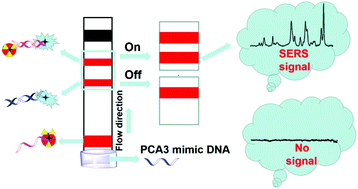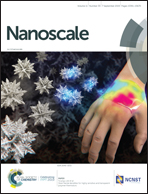Highly sensitive detection of prostate cancer specific PCA3 mimic DNA using SERS-based competitive lateral flow assay†
Abstract
Accurate analysis of prostate cancer specific biomarkers plays an important role in the early diagnosis of prostate cancer. Traditional colorimetric lateral flow assay (LFA) has the limitations of low detection sensitivity and qualitative or semiquantitative detection. In this study, we developed a novel surface-enhanced Raman scattering (SERS)-based competitive LFA for the rapid and highly sensitive quantitative evaluation of prostate cancer antigen 3 (PCA3) mimic DNA. Herein, the competitive hybridization interaction with capture DNA between target PCA3 mimic DNA and reporter DNA-labeled SERS nanotags results in a change in the amount of SERS nanotags on the test line. The quantitative analysis of target PCA3 mimic DNA was realized by monitoring the Raman peak intensity of SERS nanotags on the test line. The limit of detection of PCA3 mimic DNA was estimated to be 3 fM, which is about three orders of magnitude more sensitive than that of a commercially available kit. By combining the outstanding characteristics of the well-established SERS-based competitive strategy and LFA platform, our design has strong potential for the early diagnosis of prostate cancer and other diseases.



 Please wait while we load your content...
Please wait while we load your content...